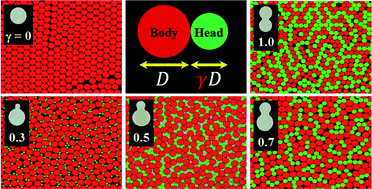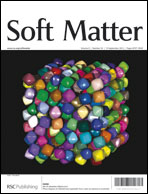Effect of bond and asymmetry of 2D-dumbbells on their structure in high concentration regime
Abstract
Particle shape is one of the major parameters governing the structure in hard-particle systems. A 2D-dumbbell, which consists of a pair of binary disks connected to each other, has two geometrical characteristics: the existence of a bond and asymmetry due to a size difference. We investigate the effects of the geometry of 2D-dumbbells on the packing structure at an air–water interface under short-range attractions, varying the area fraction φ of the particles. We observe that although the systems at low φ exhibit the characteristic structure of attractive particle systems, the short-range attraction between the particles due to capillary interaction does not affect the local structure at the maximally random jammed (MRJ) packing fraction. We investigate the influence of a rigid bond on the packing structure by comparing 2D-dumbbell systems with binary-disk systems; we also investigate the effects of asymmetry by controlling the diameter ratio (γ) of the small and large disks of the dumbbell. First, we find that the existence of a bond restricts local segregations between similar kinds of disks, so that phase-separated glass states are forbidden, contrary to the case of binary-disk systems. Second, we observe that varying γ causes a structural order–disorder–order change at high φ. While the crystalline structures of disks (γ = 0) and symmetric dimers (γ = 1) are similar in local contacting and ordering behaviors despite their shape differences, the amorphous structures of asymmetric dimers (γ = 0.3, 0.5, and 0.7) exhibit distinct features depending on γ.


 Please wait while we load your content...
Please wait while we load your content...